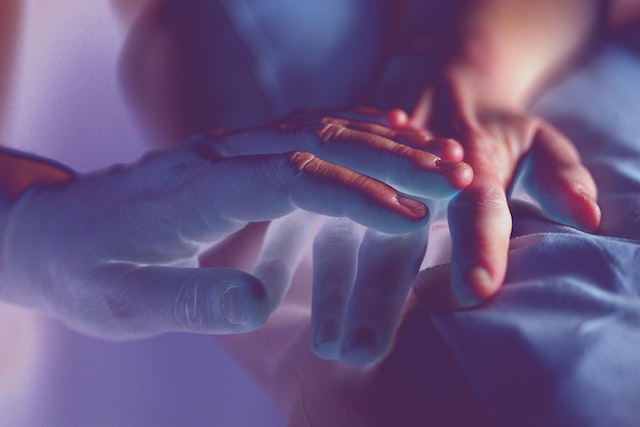 JS writes: "I have a question regarding REIKI, I have a Catholic friend who thinks it is just wonderful and pratices it on his music students. Could you please give me some information about this new age practice."
JS writes: "I have a question regarding REIKI, I have a Catholic friend who thinks it is just wonderful and pratices it on his music students. Could you please give me some information about this new age practice."Reiki is an alternative healing method based on the pantheistic belief in a universal healing energy that permeates the universe.
Practitioners believe they can channel this energy into others in order to enhance their life force. While serving as a kind of "channel," the practitioner holds their hands a few inches above various parts of the body for several minutes, supposedly allowing the patient to draw in whatever energy is needed from the universe.
In spite of claims that Reiki treatments have healed everything from cancer to toothaches, science has nothing more than anecdotal evidence to support these claims. This lack of conclusive evidence is based on the fact that there has never been any scientific proof of the existence of a universal life force energy.
But for the discerning Christian, nothing is more problematic than the process through which a person must pass in order to become a Reiki Master.
Attunement Process
Before practicing Reiki, a person must be attuned, which is a ritual during which the teacher activates the universal energy within the student. According to the Usui and Seichem Reiki Training Manual, "the Reiki attunement is a sacred spiritual initiation that connects the initiate with higher levels of consciousness and permanently connects the initiate to the Reiki source" (which is unnamed), and that "the attunement is also attended by "Reiki Guides"and other "Spiritual Beings" who help implement the process."
There are three degrees of Reiki and it is generally in the second degree that students are taught the use of sacred symbols or signs which are made on or over various parts of the body to open up or attune so-called psychic energy centers. The use of "spirit guides" usually enters the picture during this stage of initiation. Students are taught the use of mantras, which are verbal formulas or phrases, usually in Sanskrit. Some practitioners have disclosed that the mantras used in their Reiki practice are occult names and/or names of spirits received from Indian gurus and psychic channelers. The person repeats the mantra to invoke the presence of a particular divinity or spirit, which is a direct violation of the First Commandment.
The third degree of Reiki is for those who wish to become Masters. During this attunement, the student is given the "master symbol", after which time they can "attune" others to Reiki.
Persons receiving Reiki treatment are also exposing themselves to occult forces depending on the practitioner's background, their level of initiation, use of mantras and symbols and whatever spirits they may be channeling.
Grave Spiritual Dangers
Aside from the obvious dangers of associating with spiritual entities of unknown origins, Reiki also promotes the pantheistic belief that God is a universal life force.
The Vatican document, "Jesus Christ, the Bearer of the Water of Life," explains: "The New Age god is an impersonal energy . . . god in this sense is the life-force or soul of the world. This is very different from the Christian understanding of God as the maker of heaven and earth and the source of all personal life. God is in himself personal, the Father, Son, and Holy Spirit . . ."
In an effort to "Christianize" this pagan practice, some Reiki practitioners assert that the universal life force they are channeling is actually the Holy Spirit; however, this is a specious argument.
"Nowhere does Scripture teach us to "channel energy" in the way characteristic of Reiki," writes Father Gareth Leyshon, a Cardiff-trained astro-physicist. "And in fact, presuming that God will assist in a way which He has not revealed to be His will constitutes the sin of "tempting God.""
Some go so far as to claim that Jesus used Reiki to perform miracles because of how He used His hands to heal. But this argument is based on a fundamental misunderstanding of the use of the hands during Christian prayer. In the Christian tradition of laying on of hands, the hands are used as a "sign" of intercession, not a means of channeling energy.
Other spiritual dangers associated with Reiki concern the process of initiation where practitioners use secret symbols.
Fr. Leyshon explains: "If these symbols originate in a non-Christian mystical experience undergone by Mr. Usui . . . then any attempt to use them . . . constitutes a use of knowledge obtained by divination."
US Bishops Condemn Use of Reiki
The lack of scientific validity, coupled with many grave spiritual dangers associated with Reiki, caused the U.S. Conference of Catholic Bishops to issue a statement in April, 2009 condemning the practice of Reiki as "inappropriate for Catholic institutions."
"In terms of caring for one's spiritual health, there are important dangers. To use Reiki one would have to accept at least in an implicit way central elements of the worldview that undergirds Reiki theory, elements that belong neither to Christian faith nor to natural science."
Therefore, a Catholic who puts their trust in Reiki "would be operating in the realm of superstition, the no-man's-land that is neither faith nor science."
For these reasons, the bishops have concluded that the use of Reiki by Catholics either individually or in Catholic institutions such as hospitals or retreat centers is inappropriate.
Should the faithful encounter Reiki at a Catholic institution, they are encouraged to contact their bishop immediately.
This is just the "tip of the iceburg" about Reiki. A more complete treatment of this subject can be found in my book, The Learn to Discern Compendium.
© All Rights Reserved, Living His Life Abundantly®/Women of Grace® http://www.womenofgrace.com
